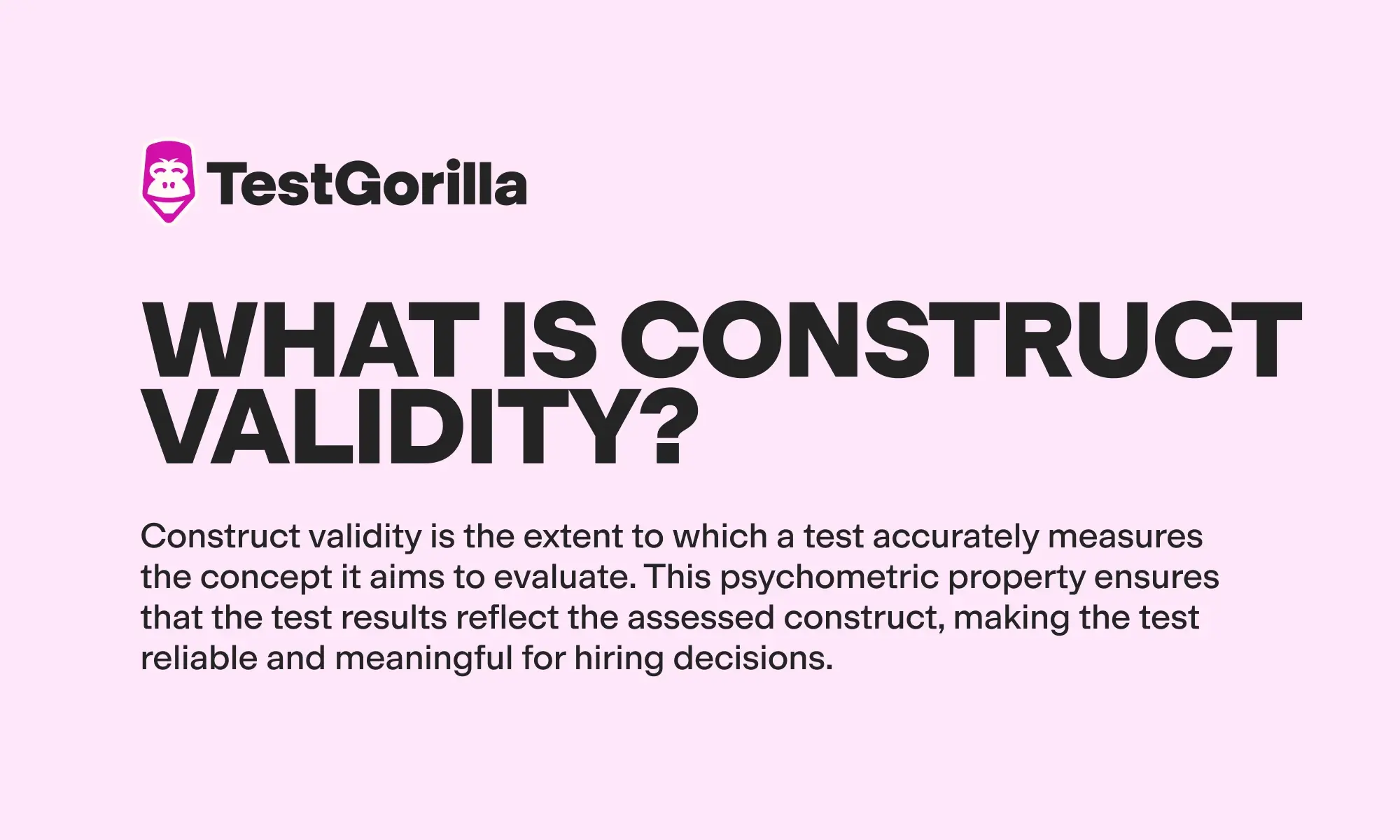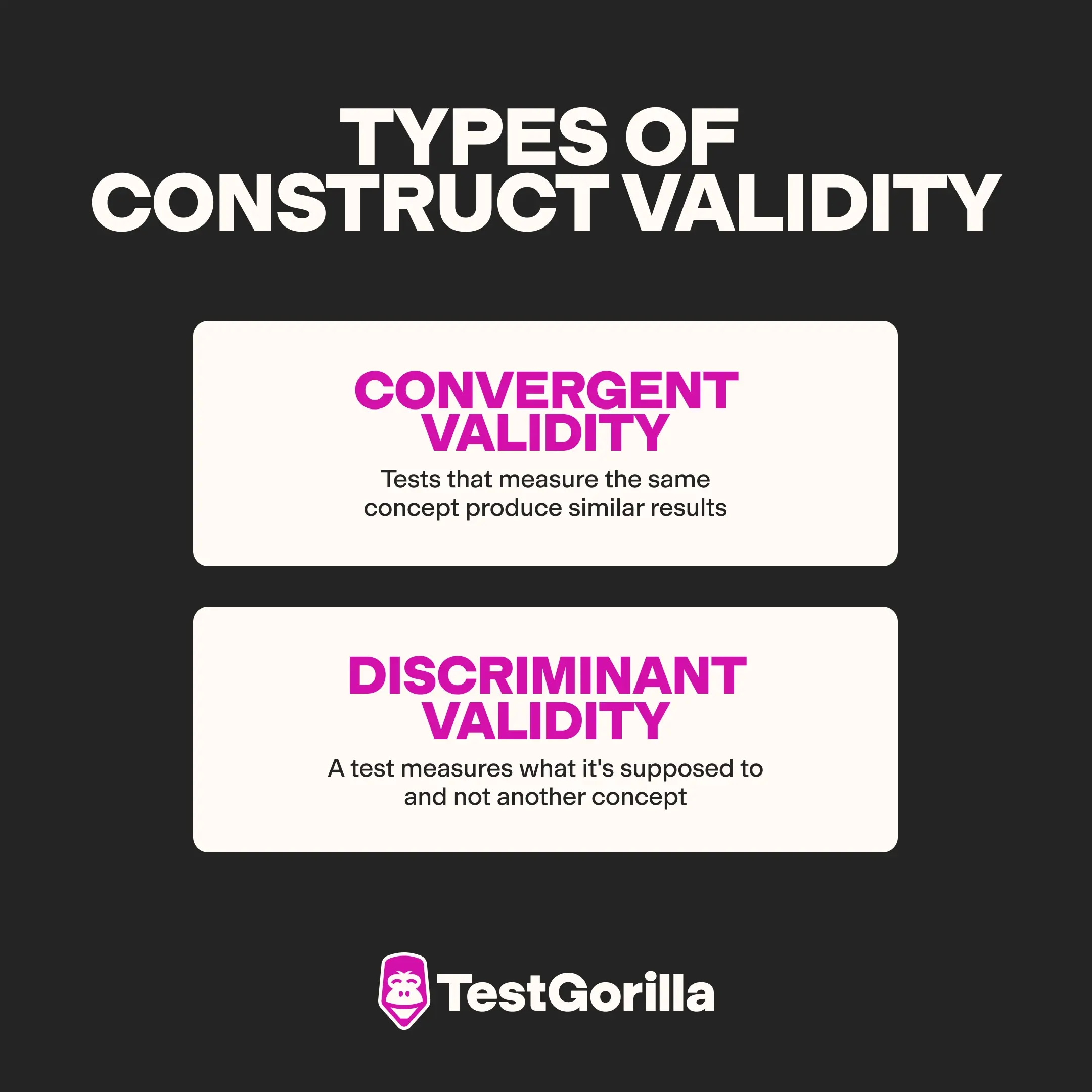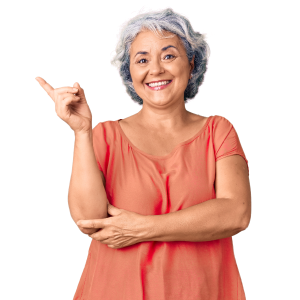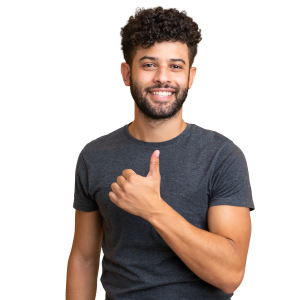Construct validity: How to measure the efficacy of skills tests
Use skills tests with excellent construct validity
Without a reliable recruitment strategy, you risk making costly hiring mistakes. A single bad hire can greatly affect your company’s productivity and increase employee turnover.
Skills tests are an excellent way to measure candidates’ skills and traits before hiring them. However, you need to ensure that the tools you use are accurate. Construct validity is one of the measures that can help you evaluate test efficacy.
In this article, we examine the construct validity definition, explore construct validity examples, and discuss the importance of using valid tests.
Table of contents
What is a construct?
A construct is an abstract concept or quality a specific test aims to measure, such as cognitive intelligence or leadership ability. It represents complex characteristics you can’t directly observe but can assess through well-designed tests.
For example, think of a theoretical construct as a brand reputation. You can’t see reputation directly but can measure it through customer reviews, social media interactions, and feedback surveys.
Similarly, you can’t directly observe leadership ability but can evaluate it through specific questions and scenarios in an assessment.
What is construct validity?
Construct validity is the extent to which a test accurately measures the concept it aims to evaluate. This psychometric property ensures that the test results reflect the assessed construct, making the test reliable and meaningful for hiring decisions.
Just like a scale should accurately measure your weight, good construct validity in psychological tests should accurately evaluate a specific concept, like leadership ability.
Considering that 82% of companies use some form of pre-employment testing in their hiring process, these assessments must be reliable and accurate.
Assessing construct validity for a skill test refers to comparing the evaluation with other measures of the same concept to discover if the results correlate and keep the test relevant to the desired outcomes.
Construct validity is one of the four types of measurement validity, which includes face validity, criterion validity, and content validity.
Face validity vs. construct validity
In the social sciences, face validity vs. construct validity are two forms of validity or different ways to judge a test. Face validity evaluates whether a test looks like it measures what it’s supposed to just by looking at it. It’s like judging a book by its cover.
Construct validity, on the other hand, digs deeper to see if the test truly measures what it claims to. It’s like reading the book and checking if the content matches the title.
Types of construct validity
In psychology research, there are two types of validity that ensure a test accurately measures the intended concept. Understanding these types is crucial for designing, selecting, or evaluating talent assessments.
Let’s discuss the two primary subtypes of construct validity: convergent and discriminant validity.
1. Convergent validity
Convergent validity refers to the degree to which two measures of the same construct correlate. In other words, if different tests that measure the same concept produce similar results, they have convergent validity.
Think of it as measuring your weight on two different scales. If they're working correctly, they should give you concurrent readings.
Convergent validity is important because it ensures that your assessment is consistent with other proven measures, which is crucial for making reliable hiring decisions.
2. Discriminant validity
Discriminant validity refers to the degree to which a test doesn’t correlate with measures of different, unrelated constructs. Essentially, it shows that your test evaluates what it should and not something else.
For example, a leadership assessment should measure leadership abilities rather than something divergent, like self-esteem.
Having a test with discriminant validity prevents overlap with unrelated qualities and improves the precision of your hiring decisions.
Keep in mind that some tests can have good convergent validity but poor discriminant validity and vice versa.
Threats to construct validity
According to research, validity is the most important consideration when developing or evaluating test methodologies.
Certain threats to construct validity can undermine a test’s effectiveness, leading to unreliable results. That’s why it’s important to understand these threats and how they affect talent assessments.
Threat | Explanation | Example |
Construct underrepresentation | Occurs when the test doesn’t fully capture all aspects of the intended construct, leading to incomplete assessment | A leadership test that only measures decision-making skills but ignores other important abilities like effective communication |
Construct irrelevant variance | Happens when separate but related constructs influence the test results, causing inaccurate measurement methods | A critical thinking test influenced by the candidate’s computer skills |
Confounding variables | Variables that unintentionally affect the results, making it difficult to determine if the construct is measured correctly | Taking a time management test in a noisy test environment, which influences the outcome |
Test bias | When the test unfairly gives an advantage or disadvantage to certain groups, leading to results that don’t reflect the construct | A cognitive ability test that is biased against non-native English speakers, resulting in lower test scores |
Response bias | Occurs when respondents make inferences in a way they think is expected or socially desirable rather than truthful | A personality test where candidates pick the answer more likely to get them the job, like claiming to enjoy constant micromanaging |
Don’t worry about threats to construct validity; use TestGorilla!
We’ve already done the heavy lifting of designing, testing, refining, and optimizing our tests, meaning you only have to worry about building the perfect assessment. Find out more today.
How to measure construct validity
If you want to ensure your talent assessments accurately measure your construct of interest, you need to measure their construct validity. Here’s how to measure the construct validity of your skills tests.
1. Define the term you aim to measure
Different people can interpret the construct you want to evaluate in various ways. That’s why you need to define a new measure or construct clearly to confirm that you and the test provider have a similar understanding.
A precise construct validity definition helps avoid ambiguity and ensures the assessment focuses on the specific traits or skills you want to evaluate. This clarity is essential for non-specialized tests, where the risk of misinterpretation is higher.
Here’s how to define the concept you want to measure:
Consult subject matter experts to gather insights and ensure your definition is comprehensive and accurate
Review existing research methods and validated assessments to see how similar constructs are defined and measured
Identify and list the specific traits, behaviors, or skills that make up the construct
Avoid vague terms and ensure the definition is easy to understand for everyone
Confirm the construct aligns with the specific needs and objectives of your organization
Test your definition with a small group to check for understanding and refine it based on feedback
2. Provide proof that your test evaluates what you want
You should explain the rationale behind the questions you ask to determine test validity.
The next step is to provide evidence of why your questions relate to the concept you defined and discuss why you believe the test takers’ answers represent their capabilities in a specific area.
For example, if you want to evaluate a candidate’s communication skills, you must clearly define them and explain how the test’s questions and potential answers determine its outcome.
Without this proof, your assessment’s results could be unreliable and ineffective for making informed decisions.
Here are a few actionable tips on how you can provide proof of test validity:
Link each question to the specific aspect of the construct you aim to measure
Conduct construct validation studies to compare the human evaluation of the construct with the test’s assessment of the same attributes
Perform pilot studies with a small group of participants to gather initial data
Use data to refine the questions and ensure they accurately measure the intended construct
Involve subject matter experts to empirically review the questions and provide feedback on their relevance
3. Provide proof that your test relates to other similar tests
To ensure the validity of your skills test, you must show its effectiveness compared with other established tests. This step is crucial for confirming its wider applicability and reliability.
Using the same example of a test examining communication abilities, your definition of these skills could be how well a person uses verbal and written communication to support productivity and effectiveness in the workplace.
To prove that your assessment remains valid in other contexts, find similar tests that evaluate how well a person can use verbal and written communication in the workplace and compare the results.
Examine the trends in your data analysis and check for similarities with the other test. If the data in both tests correlates, your test is likely valid.
Using statistical methods, such as correlation coefficients, is the best approach to confirm the relationship between your test and similar assessments. High correlation values suggest strong convergent validity.
Finally, you can perform test validation studies where you administer your test and an established test to the same group of participants. If the results are consistent across both tests for all participants, it’s another proof of construct validity.
4. Test and refine your assessment
Regular testing and refinement help maintain the quality of your assessment, ensuring it provides reliable results over time. That way, you can quickly identify and address any issues that affect your test validity.
The best way to test and refine your assessment is to:
Ask test-takers to self-report and subject matter experts to provide feedback to understand where the test falls short
Use statistical methods to evaluate the test’s reliability and validity
Based on the data analysis and feedback, refine the test items to improve clarity, relevance, and research design
Remove or revise any questions that don’t contribute to measuring the construct
Repeat the process to bring the assessment closer to providing reliable results
Keep detailed records of all changes made during the refinement process to provide a basis for future adjustments
Use reliable talent assessments from TestGorilla
Reliable talent assessments help you identify the best candidates based on their skills and potential rather than relying solely on resumes. This approach benefits you and the candidate, leading to better-quality hires and higher performance.
In fact, 89% of employers using talent assessments and skills-based hiring believe this approach is more effective than resume-centric recruitment.
Why is that?
Skills-based hiring offers several advantages over traditional resume screening:
Objective evaluation: Talent assessments provide objective data on candidates’ skills, which reduces biases that can occur during resume reviews
Better person-organization fit: By focusing on actual skills and traits, you confirm candidates are well-suited for the job, which leads to higher satisfaction and reduced turnover
Improved efficiency: Automated assessments streamline the hiring process, saving time and resources and securing high-quality hires
Take a look at Boat&Click, for example. This boat-renting platform turned to TestGorilla to hire higher-quality customer support agents more quickly. The role requires a unique mix of cognitive thinking, technical abilities, and soft skills.
Thanks to our talent assessments with high construct validity, the company easily recruited top-quality candidates. To make things even better, employees hired with our skills tests are 30% more productive than the rest of the team.
To illustrate how you can use our platform to discover better talent, let’s say you need to find a new project manager. This role requires a mix of specific knowledge, soft skills, and personality traits. That’s why you can create an assessment using these five skills tests:
Project Management test to assess a candidate’s knowledge and skills in managing projects, including planning, execution, and completion
Business Ethics and Compliance test to evaluate an applicant’s ability to understand and adhere to business ethics and compliance standards
Communication test to measure how effectively a person can communicate in various professional settings, including verbal and written communication
Problem Solving test to assess a candidate’s potential to analyze problems, think critically, and come up with effective solutions
Leadership and People Management test to evaluate leadership skills and the ability to manage and inspire teams
Discover top talent with talent assessments
Unlock the power of valid and reliable talent assessments to find candidates better and faster. Sign up for our free plan and start planning the perfect assessment.
Avoid bad hires with reliable skills tests
Establishing construct validity and reliability of your skills tests helps avoid bad hires and ensures a bias-free recruitment process.
The best approach is to search for credible talent discovery platforms like TestGorilla, which offers hundreds of tests with high validity. We do all the heavy lifting of designing, testing, refining, and optimizing tests.
All you have to do is sign up for a Free forever plan and start using our talent assessments to hire better candidates.
You can also take a product tour to discover how you can reinvent your recruitment process.
Or book a live demo to learn more about our talent assessments and how you can personalize them to best fit your hiring needs.
Construct validity FAQs
In this section, you can find answers to the most common questions about construct validity.
What determines construct validity?
Construct validity determines how well a test measures the concept it intends to assess. It involves verifying that the test aligns with theoretical expectations and correlates with different measures of the same construct. Key approaches to confirm construct validation include expert evaluations, factor analysis, structural equation modeling, and correlational studies with established tests. Consistent evidence across these formats supports strong validity.
What is construct validity vs. content validity?
Construct validity measures how well a test reflects the theoretical concept it aims to assess, while content validity evaluates whether the test covers the entire concept. It focuses on the extent to which test items represent the construct comprehensively and accurately. Although you could wonder whether content validity vs. construct validity is more important, both are crucial for effective assessments.
What is an example of good construct validity?
A good example of construct validity is a test that accurately measures mathematical reasoning skills, correlates highly with other established math tests, and has predictive validity for performance in math-related tasks. For example, if students who score well on this test also excel in math courses and standardized math exams, it shows strong construct validation, indicating the test accurately measures mathematical reasoning.
Related posts
Hire the best candidates with TestGorilla
Create pre-employment assessments in minutes to screen candidates, save time, and hire the best talent.
Latest posts
The best advice in pre-employment testing, in your inbox.
No spam. Unsubscribe at any time.

Hire the best. No bias. No stress.
Our screening tests identify the best candidates and make your hiring decisions faster, easier, and bias-free.
Free resources
This checklist covers key features you should look for when choosing a skills testing platform
This resource will help you develop an onboarding checklist for new hires.
How to assess your candidates' attention to detail.
Learn how to get human resources certified through HRCI or SHRM.
Learn how you can improve the level of talent at your company.
Learn how CapitalT reduced hiring bias with online skills assessments.
Learn how to make the resume process more efficient and more effective.
Improve your hiring strategy with these 7 critical recruitment metrics.
Learn how Sukhi decreased time spent reviewing resumes by 83%!
Hire more efficiently with these hacks that 99% of recruiters aren't using.
Make a business case for diversity and inclusion initiatives with this data.

























